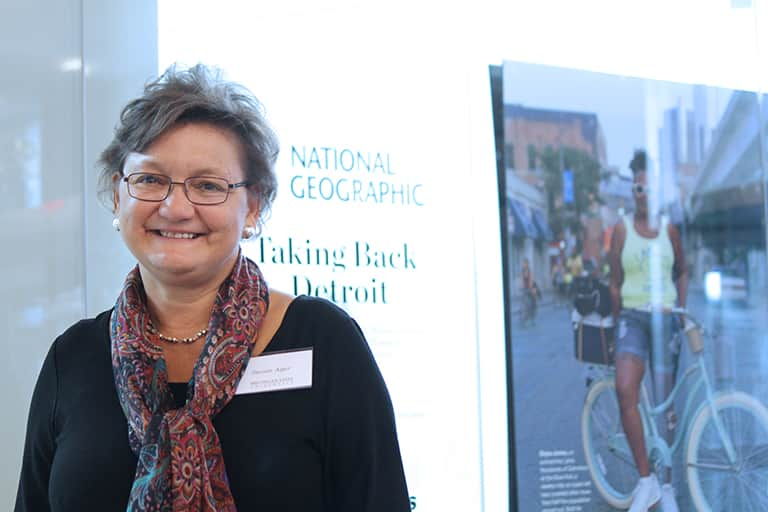When National Geographic set out to tell the story of Detroit’s comeback – a story unlike any other that have been told, one that would give a richer, deeper exploration of the people who call the Motor City home – the magazine called upon ComArtSci alumna Susan Ager.
Born in Detroit, Ager worked for the Detroit Free Press for 25 years as a writer, editor and columnist before retiring in September 2008. She knows Detroit, its people, its politics, the stories, the hardships, the triumphs.
“A complete stranger to Detroit could have come in and done the story, but it would have required lots more time,” said Ager, B.A Journalism ‘75. “Not that anyone can fully understand a place, but I came in understanding it more than someone who’d never given it much thought…And because I could share my own Detroit history, people I spoke with knew I cared, too. Detroit wasn’t just an assignment.”
But even with all her experience and knowledge of Detroit, Ager said she didn’t accept the assignment right away. She first considered whether she could meet National Geographic’s high standards.
“I spent a couple weeks thinking about the challenge before I accepted the assignment,” Ager said. “I knew I would be writing about Detroit for the world, not just for Americans or Detroiters.”
National Geographic Editor-In-Chief Susan Goldberg, also a ComArtSci alumna, who had once worked with Ager on the editorial staff at the Detroit Free Press, was confident Ager was the right person to tell Detroit’s story.
“Whenever I read stories about Detroit, I never felt like they got the story right. I felt this coverage lacked an understanding of the historic forces that had brought the city to the brink or that failed to reflect the spirit of the people who live here,” said Goldberg, B.A. ’84 Journalism. “Once I got to National Geographic about 15 months ago, I was confident we could tell Detroit’s story in a more accurate and unique way. So we hired somebody who really, really knows Detroit – longtime Free Press columnist Susan Ager, a Detroit native and another MSU grad – to write the story.
“And, I think the results speak for themselves. No matter how much you’ve read about Detroit, you haven’t read or seen a story like this one, because in the end it’s all about the people.”
Ager’s National Geographic article, “Taking Back Detroit,” introduces readers to several Detroit residents and the roles they are playing in the city’s rebirth.
“I spent months reading everything I could and speaking with everyone I could find about Detroit,” Ager said. “Once I hit the streets of Detroit, I wandered some, stopping men and women on the streets, but also made appointments to see others I’d heard about. I looked for people who were either changing Detroit themselves, or coping with change surrounding them. I wanted both old-timers and newcomers. In all, I probably interviewed about 50 Detroiters.”
Taking Back Detroit appeared in the May 2015 issue. It was Ager’s first National Geographic assignment.
“This story about Detroit and its amazing people will reach 40 million readers of our magazine in the United States and tens of millions more on our digital platforms,” Goldberg said. “Most people don’t realize it, but among the top 25 magazine, we have the largest social media footprint of any of them, so this story is going to be read by a whole lot of people."
